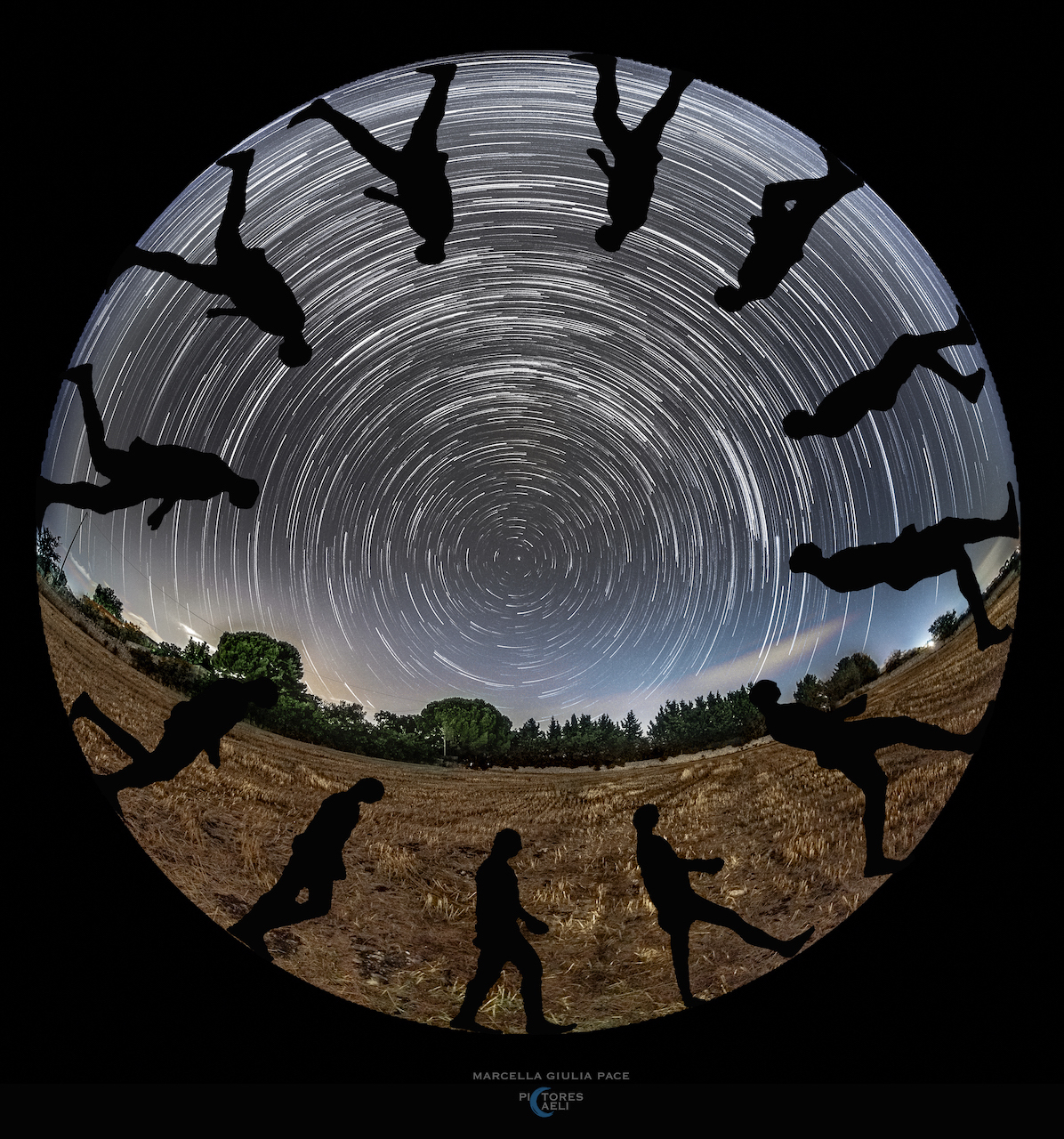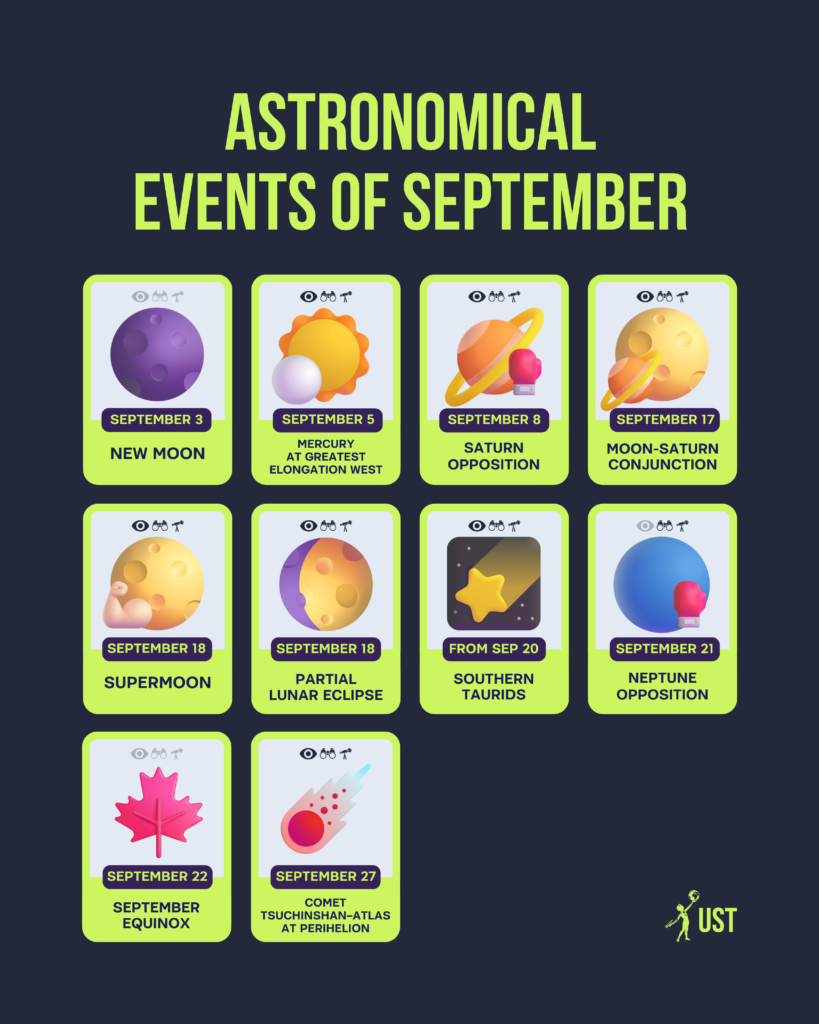September is a month of astronomical contrasts. On the one hand, we say goodbye to the summer sky and bright stars. On the other hand, we meet new space phenomena that promise unforgettable observations and photos. Let’s take a look at what awaits us in September 2024.
Goodbye to summer or what will disappear from the night sky

Source: Oleksander Pozdniakov
We are gradually losing the magnificent visibility of the Galactic center of the Milky Way. Its gorgeous glow is increasingly disappearing over the horizon, and already in November we say goodbye to it completely until next year.
What will appear in the sky?
- Star Trails: They produce outstanding photos. Remember to set your camera or smartphone on a tripod and take long exposures.
- Zodiacal Light: This faint, cone-shaped glow of dust in the Solar System will become more noticeable in September. The best time to observe it is before dawn in the east (Northern Hemisphere) or after dusk at sunset (Southern Hemisphere).

Source: Marcella Giulia Pace
- Planets: Mercury will be at its westernmost elongation, while Saturn and Neptune will be in opposition. This is an ideal time to observe these celestial bodies.
- Moon: We will have a Supermoon and a partial lunar eclipse. These are great opportunities to create dramatic moonscapes.
- Comets: Comet C/2023 A3 (Tsuchinshann-ATLAS) could be a real surprise. If it continues to get brighter, it could be seen with the naked eye.
Here’s a complete list of the most important celestial events that will take place in September 2024.
September 3: New Moon
Time: 02:55 a.m. in London
09:55 p.m. in New York
Visibility: Not visible

Source: TWAN / APOD
Do you want to see the starry sky in all its beauty? Then mark September 3 on your calendar! The Moon will be between the Earth and the Sun, so it won’t be visible in the sky. This is an ideal time for astronomical observations because the night sky will be dark and clear.
September 5: Mercury at its westernmost elongation
Time: 05:00 a.m. local time
Visibility: with the naked eye

Source: Pierluigi Giacobazzi
During Mercury’s maximum elongation (stellar magnitude -0.4m), the planet will be at its greatest angular distance from the Sun and will be easily visible above the eastern horizon before sunrise: the celestial bodies will be separated by a distance of 18°6′. This is the best time to capture the first planet of the Solar System!
September 8: Saturn’s opposition
Visibility: with the naked eye

Source: Andy Casely
Saturn, Earth and the Sun will line up, and Saturn will be closer to us. Therefore, we will be able to see it brightest – its luminosity will be 0.6m.
Saturn will be in the constellation Aquarius. It will appear as a bright yellowish star to the naked eye. You will need at least a small telescope to see its famous rings.
September 17: Saturn-Moon conjunction
Time: 11:04 a.m. in London (can’t be observed)
06:14 a.m. in New York (can’t be observed)
Visibility: Not visible

Source: Chengcheng Xu / APOD
The Moon will approach Saturn at a minimum distance of only 16 angular minutes. In addition, residents of Western North America, Australia and other countries will be able to observe Saturn’s occultation of the Moon.
The Moon will be almost full (96.9%) and Saturn’s brilliance will be 0.6m. Both will be in the constellation Aquarius.
September 18: Super Moon
Time: 03:34 a.m. in London
10:34 p.m. in New York
Visibility: with the naked eye
Suitable for astrophotography

The September Full Moon will be special because the Moon will appear much bigger and brighter to us. This phenomenon is called a Super Moon.
This Full Moon was known to early Indian tribes as the Corn Moon because corn is harvested around this time of year. It is also known as the Harvest Moon. This is the name given to the Full Moon that occurs closest to the September equinox each year.
September 18: Partial lunar eclipse
Time: 01:41 a.m. – 05:47 a.m. in London
08:41 pm – 00:47 a.m. in NY
Visibility: with the naked eye
Suitable for astrophotography

Source: Callum aka Wanderloots
On the night of September 18, there will be an interesting astronomical phenomenon – a partial lunar eclipse. During this eclipse, the Moon will pass through the Earth’s shadow, and we will see part of its surface darkened. It will look like someone chewed a piece off the Moon.
The September eclipse can be seen from most of the Earth, including Europe, Asia, Africa, North and South America, Australia and Antarctica. In contrast to the penumbral eclipse in March, this time the Moon will pass through part of the shadow, making the eclipse more noticeable.
September 20 – November 20: South Taurids
Peak: November 5.
Visibility: with the naked eye

The Southern Taurids is a meteor shower active for two months, from the end of September to the end of November. The radiant of the shower is located in the constellation Taurus. The maximum number of meteors that can be observed per hour (ZHR) is about 5.
Unlike other starfalls, the Southern Taurids don’t have one clear maximum of activity. However, you can expect the most meteors on the night of November 5. This starfall is known for the frequent observation of bright fireballs called bolides.
Although this meteor shower doesn’t promise us a massive star shower, it’s still a great opportunity to get away from your everyday routine and immerse yourself in contemplation of the night sky. Each meteor flare will be a special moment, and the telescope will help you view even more interesting celestial objects. Invite your friends, bring a blanket and a thermos with hot tea, and enjoy an evening under the stars!
September 21: Neptune in opposition
Visibility: with binoculars or telescope

Source: Alexis Trigo
During the opposition, Neptune will be in line with the Earth and the Sun. Its apparent stellar magnitude will be 7.8m, making it the brightest during this period. Search for Neptune in the constellation of Pisces.
September 22: Beginning of astronomical autumn
Time: 01:44 p.m. in London
08:44 a.m. in NY
Visibility: Not visible
Source: NASA Earth Observatory
On this day, the Sun will pass directly over the equator, therefore day and night will be of the same duration throughout the Earth. For us, the inhabitants of the Northern Hemisphere, it is the beginning of astronomical autumn, and for the inhabitants of the Northern Hemisphere, it is the beginning of spring.
September 27: Perihelion of comet C/2023 A3 (Tsuchinshan – ATLAS)
Visibility: in a telescope, after perihelion – with the naked eye
Suitable for astrophotography

Source: Pavlo Pakhomenko
This comet may become the main astronomical event of the autumn of 2024! It will reach perihelion on September 27, 2024, and its maximum approach to Earth on October 12, 2024.
The comet is expected to become visible to the naked eye and reach a stellar magnitude of -0.9. This means that it will be one of the brightest objects in the night sky. The comet is best observed in the Southern Hemisphere before perihelion and in the Northern Hemisphere afterward.

The most spectacular astronomical events of September 2024. Source: Universe Space Tech
September is the perfect time for astronomical observations. Dark nights, clear skies and amazing celestial phenomena create all the conditions for an unforgettable experience. Take a warm blanket, a cup of hot tea and make your way to the stars!
Are you ready to look up and dive into limitless space?

